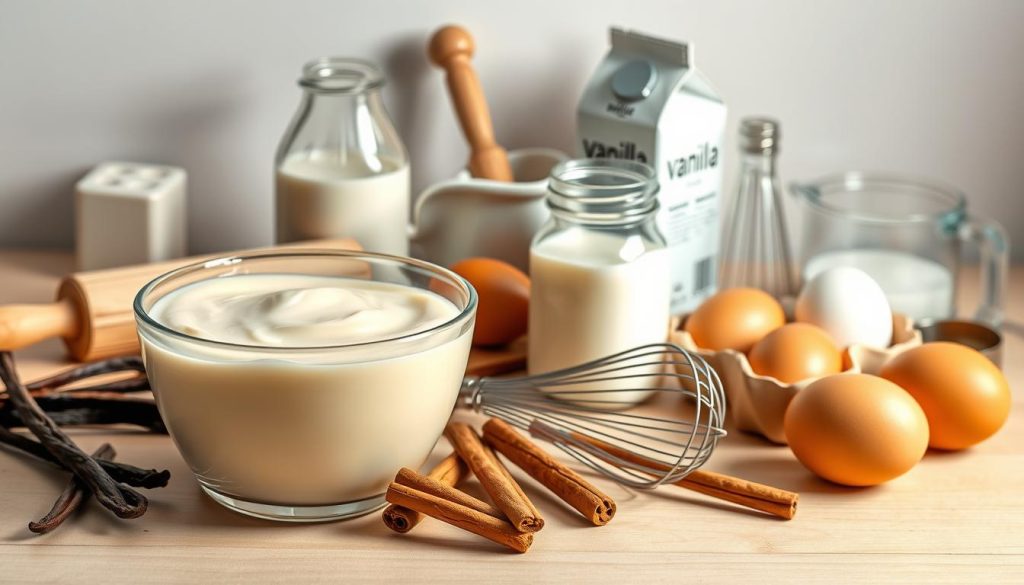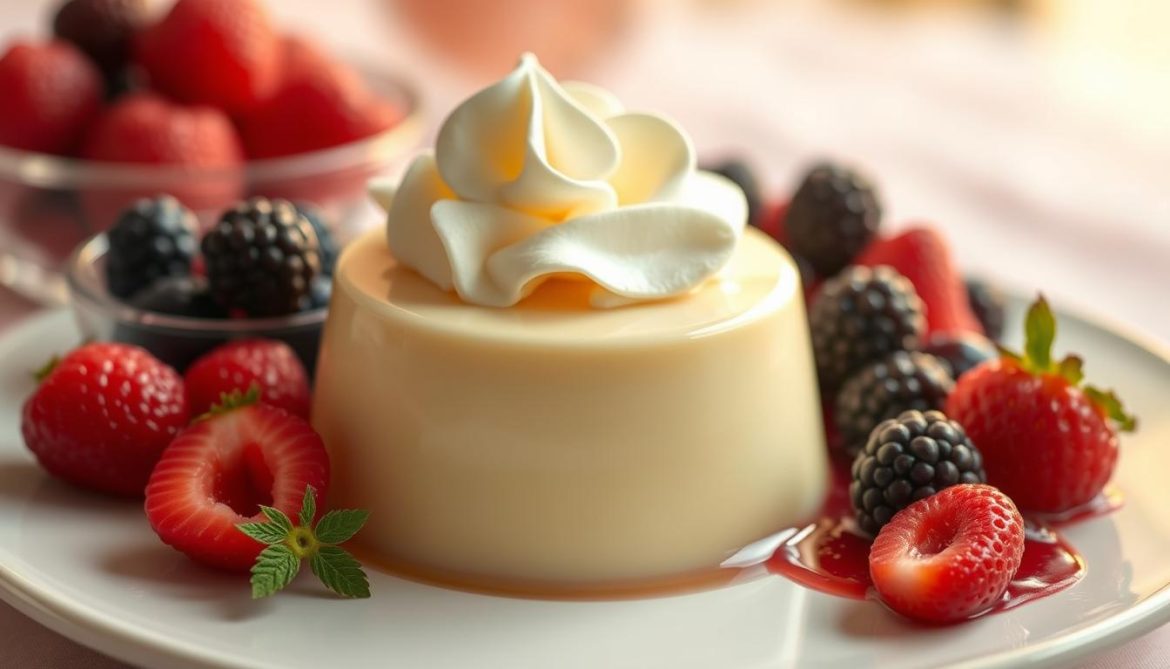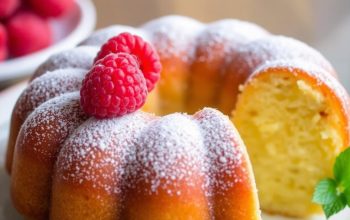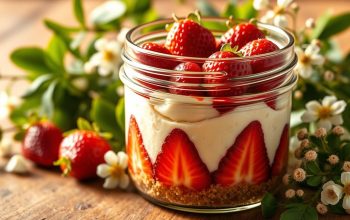Welcome to the ultimate comfort food adventure! Vanilla pudding is more than just a dessert. It’s a creamy canvas of culinary magic that turns simple ingredients into pure bliss. This classic custard dessert has been warming hearts and satisfying sweet cravings for generations.
Imagine a silky-smooth vanilla pudding that literally melts in your mouth. It’s topped with a vibrant fruit compote that adds a burst of natural sweetness. Whether you’re a dessert rookie or a kitchen pro, this recipe will become your new go-to treat for any occasion.
Here comes the recipe for Classic Vanilla Pudding with Fresh Fruit Compote
What makes this vanilla pudding special isn’t just its incredible taste. It’s the love and care you’ll put into every single step. From selecting the perfect ingredients to mastering the art of creating that signature creamy texture, I’ll guide you through every delicious moment of preparation.
Classic recipes like this vanilla pudding connect us to culinary traditions passed down through generations. It’s more than food – it’s a delectable journey that brings people together, creating memories one spoonful at a time.
Get ready to transform your kitchen into a dessert paradise! We’ll explore the secrets of creating the most incredible vanilla pudding you’ve ever tasted. Grab your whisk, and let’s dive into this sweet adventure!
The History and Evolution of Classic Vanilla Pudding
Explore the world of egg-based desserts that have delighted us for centuries! Vanilla pudding is more than a sweet treat. It’s a journey through cultures and generations. Let’s discover how this creamy delight became a favorite today.
Origins of Custard-Based Desserts
The tale of vanilla pudding starts in medieval kitchens. Cooks there first turned simple ingredients into magical sweets. Custard-based desserts were a luxury, blending milk, eggs, and sweet flavors into a smooth texture.
- Ancient Romans first documented egg-based custard recipes
- Medieval European kitchens refined custard-making techniques
- Vanilla was introduced from the Americas in the 16th century
From Medieval Times to Modern Comfort Food
Vanilla pudding evolved from a royal treat to a comfort food loved by all. The industrial revolution made it easier to make at home. Now, everyone can enjoy these sweet treats.
| Time Period | Pudding Characteristics | Cultural Significance |
|---|---|---|
| Medieval Era | Handmade, labor-intensive | Luxury for nobility |
| 19th Century | More standardized recipes | Growing middle-class favorite |
| 20th Century | Mass-produced options | Universal comfort food |
Cultural Significance Across Cuisines
Every culture has its own twist on vanilla pudding. From English custards to French crème pâtissière, it’s a global favorite. This dessert shows how different tastes come together in sweet comfort foods.
“A good pudding can heal the soul and bring people together!” – Traditional Culinary Saying
Essential Ingredients for Perfect Vanilla Pudding
Creating the most delightful creamy treats starts with understanding the magic behind each ingredient. Let’s explore the key components that transform simple ingredients into a luxurious baked custard. This will make your taste buds dance!

The foundation of an incredible vanilla pudding lies in selecting high-quality ingredients. I’ll break down the essential elements you’ll need to craft this dreamy dessert:
- Whole Milk: Provides rich, creamy texture
- Fresh Egg Yolks: Adds silky smoothness
- Pure Vanilla Extract: Delivers deep, authentic flavor
- Granulated Sugar: Balances sweetness
- Cornstarch: Ensures perfect thickening
Choosing the right vanilla can elevate your pudding from good to extraordinary. I recommend using pure vanilla extract rather than artificial flavoring. Your taste buds will thank you!
“The quality of your ingredients determines the soul of your dessert.” – Pastry Chef Wisdom
Let’s dive into a quick ingredient comparison for your creamy treats:
| Ingredient | Quality Impact | Recommended Type |
|---|---|---|
| Milk | Creaminess | Whole Milk (3.25% fat) |
| Vanilla | Flavor Depth | Pure Madagascar Bourbon Vanilla |
| Eggs | Texture | Fresh Large Egg Yolks |
Pro tip for baked custard lovers: Room temperature ingredients blend more smoothly and create a more consistent pudding. Take your eggs and milk out of the refrigerator about 30 minutes before cooking!
Step-by-Step Guide to Creamy Vanilla Pudding
Vanilla Pudding with Fruit Compote
Nutrition
Equipment
- Medium saucepan
- Whisk
- Mixing Bowls
- Fine-mesh strainer
- Serving glasses or bowls
Ingredients
For the Vanilla Pudding
- 2 cups whole milk
- 1/2 cup heavy cream
- 1/2 cup granulated sugar
- 3 tbsp cornstarch
- 1/4 tsp salt
- 2 large egg yolks
- 1 vanilla bean or 2 tsp vanilla extract
- 1 tbsp unsalted butter
For the Fruit Compote
- 1 cup mixed berries strawberries, raspberries, blueberries
- 1/4 cup orange juice
- 2 tbsp honey or maple syrup
- 1/2 tsp lemon zest
- 1/2 tsp vanilla extract
For Garnish
- fresh mint leaves
- extra berries
- powdered sugar for sprinkling
Instructions
Making the Vanilla Pudding
- In a medium saucepan, whisk together sugar, cornstarch, and salt.
- Slowly whisk in the milk and heavy cream until smooth.
- Add the vanilla bean seeds and the pod (if using extract, add later).
- Heat over medium, stirring constantly, until the mixture begins to thicken.
- In a separate bowl, whisk the egg yolks.
- Slowly add a few spoonfuls of the hot milk mixture to the yolks, whisking continuously.
- Pour the tempered yolks back into the saucepan, stirring constantly.
- Cook for another 2 minutes until thickened, then remove from heat.
- Stir in the butter and vanilla extract (if not using vanilla bean).
- Strain through a fine-mesh sieve for extra smoothness.
Preparing the Fruit Compote
- In a small saucepan, combine the mixed berries, orange juice, and honey.
- Bring to a simmer over medium heat, stirring occasionally.
- Let cook for about 5 minutes, until the berries soften and release their juices.
- Add the lemon zest and vanilla extract, stirring well.
- Remove from heat and let cool slightly.
Assembling the Dessert
- Pour the vanilla pudding into serving glasses or bowls.
- Top with the warm or chilled fruit compote.
- Garnish with fresh mint, extra berries, and a light dusting of powdered sugar.
- Serve immediately or refrigerate for a few hours for a chilled version.
Tips and Variations
- Dairy-Free: Use coconut milk and replace butter with coconut oil.
- Extra Crunch: Sprinkle with toasted nuts or granola.
- Chocolate Twist: Add 2 tbsp cocoa powder to the pudding for a chocolate version.
- Whisk constantly while heating the pudding to prevent lumps.
- For an extra creamy texture, let the pudding chill for at least 2 hours.
- Use seasonal fruits for the compote for a fresh twist.
Preparing the Base Mixture
The foundation of a great vanilla pudding starts with the right ingredients. You need a mix of milk, sugar, eggs, and vanilla extract. Here’s a foolproof method to create your base:
- Gather fresh, high-quality ingredients
- Measure ingredients precisely
- Use room temperature eggs for smooth mixing
Proper Stirring Techniques
Stirring is key to a smooth vanilla pudding. You need gentle, consistent movement. This prevents lumps and ensures even heating. Use a whisk or wooden spoon and stir in a figure-eight motion.
| Technique | Purpose |
|---|---|
| Constant Stirring | Prevents burning and lumps |
| Figure-Eight Motion | Ensures even heat distribution |
| Medium-Low Heat | Allows gradual thickening |
Achieving the Perfect Consistency
The magic of vanilla pudding is in its texture. Watch for visual cues that show your pudding is ready:
- Mixture should coat the back of a spoon
- Pudding begins to thicken slightly
- Temperature reaches around 175-180°F
“Patience is the secret ingredient in creating the most luxurious vanilla pudding!” – Pastry Chef Recommendation
Remember, practice makes perfect. Don’t get discouraged if your first batch isn’t flawless. Each attempt brings you closer to pudding perfection!
Creating a Vibrant Fruit Compote Topping
Turn your vanilla pudding into a showstopper with a homemade fruit compote. This topping adds a burst of flavor, making your dessert cups stand out. The key is choosing the right fruits and cooking them perfectly.
Let’s explore how to make the best fruit compote. I’ll share my top tips for a topping that will delight your taste buds!
Choosing Your Fruits
- Select ripe, seasonal fruits for maximum flavor
- Mix complementary fruits for complex taste profiles
- Consider texture and natural sweetness
My favorite mix includes:
- Strawberries for bright, tangy notes
- Blueberries for deep, rich flavor
- Peaches for smooth, sweet undertones
“A great compote is like a symphony of flavors dancing on your palate!” – Pastry Chef’s Secret
To make your compote, cook the fruits gently. This keeps their shape and creates a rich syrup. Pro tip: Adding a bit of vanilla extract or cinnamon can make it even better!
These fruit-topped desserts aren’t just for pudding. Try them on breakfast yogurts, pancakes, or even cheesecakes. Your creativity has no limits!
Tips for Serving and Presentation
Turning your classic vanilla pudding into a stunning dessert is all about the details! Whether you’re preparing for a casual family dinner or an elegant gathering, presentation can transform your classic recipes from simple to spectacular.
Garnishing Ideas That Wow
Elevate your dessert cups with these creative garnishing techniques:
- Sprinkle toasted almond slivers for a delightful crunch
- Add fresh mint leaves for a pop of color
- Dust with cocoa powder or cinnamon for an elegant touch
- Scatter edible flowers for a gourmet presentation
Temperature Considerations
The perfect serving temperature can make or break your dessert experience. Chilled pudding typically tastes best, offering a refreshing and smooth texture. Aim to serve your vanilla pudding straight from the refrigerator, keeping it cool for maximum enjoyment.
Make-Ahead Storage Solutions
Planning ahead? No problem! Your homemade pudding can be prepared in advance with these simple storage tips:
- Store in airtight dessert cups with plastic wrap directly touching the surface
- Refrigerate for up to 3-4 days
- Keep fruit compote separate until serving to maintain texture
“The secret to a great dessert is not just in the recipe, but in the love and care you put into presenting it.” – Culinary Wisdom
Pro tip: Always let your pudding sit at room temperature for 5-10 minutes before serving. This will soften it slightly and enhance its creamy texture. Your guests will be impressed by the professional touch!
Troubleshooting Common Pudding Problems
Ever found yourself staring down a lumpy vanilla pudding or battling a runny custard dessert? Don’t panic! Making perfect egg-based desserts takes practice. Every kitchen mishap is a chance to learn. I’ve been through countless pudding challenges and discovered some game-changing rescue techniques.
Lumpy texture got you down? The secret is gentle, consistent stirring and controlling your heat. Whisking continuously prevents those dreaded egg protein clumps in your custard desserts. If lumps have already formed, try straining your vanilla pudding through a fine-mesh sieve to restore that silky smooth texture everyone loves.
Runny pudding can be just as frustrating. The key is understanding the science behind egg-based desserts. If your mixture hasn’t thickened, it might need more cooking time or a touch more cornstarch. Low heat and patient stirring are your best friends. Remember, pudding continues to set as it cools, so don’t overcompensate by cooking too long!
Pro tip: Always keep your ingredients at room temperature and measure precisely. Baking is part art, part science – especialy with delicate vanilla pudding. With these tricks up your sleeve, you’ll transform potential kitchen disasters into creamy, dreamy dessert victories! 🍮✨



